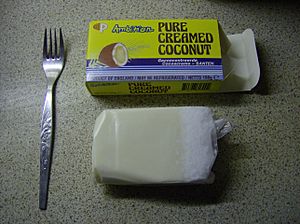Creamed coconut facts for kids
Creamed coconut, also known as coconut butter, is a special product made from coconuts. It's created by grinding the dried, fresh inside part (pulp) of a ripe coconut. This makes a thick, white, creamy paste.
You usually find creamed coconut sold as a hard white block. It can be kept at room temperature. If it's warm, like over 24°C (75°F), it might become a softer, liquid paste because the coconut oil in it melts. These blocks often come in a sealed plastic bag. Sometimes, you might see the fat and coconut flesh separated a little bit.
When you want to use it in cooking, you can chop it into small pieces or grate it. It's great for making your own coconut milk or coconut cream! Just add warm water. For a thicker coconut cream, mix 5 parts water with 2 parts creamed coconut. For a thinner coconut milk, use 5 parts water with 1 part creamed coconut.
Contents
What is Creamed Coconut Used For?
Creamed coconut is a popular ingredient in many different cuisines around the world.
Cooking Around the World
- Asian and Caribbean Dishes: It's often added to recipes from India, Southeast Asia, and the Caribbean. It helps make curries and sauces richer and more flavorful.
- Western Desserts: In Western cooking, it's mostly used in sweet treats. You can find it in candies, desserts, ice cream, and various sauces.
Creamed Coconut vs. Coconut Cream
It's easy to get creamed coconut mixed up with coconut cream, but they are different. Coconut cream is a liquid that's squeezed out of the coconut pulp. It doesn't include the solid coconut pulp itself. Creamed coconut, however, is made from the whole dried pulp, so it's much thicker and contains all the fiber and fat from the coconut flesh.
Is Creamed Coconut Healthy?
Creamed coconut can be a good addition to your diet.
Nutritional Facts
- It does not contain cholesterol.
- It's a good source of fiber, which helps your digestion.
- It also provides potassium, an important mineral for your body.
Here are some typical values for every 100 grams of creamed coconut:
- Energy: 684.00 calories
- Protein: 5.30 grams
- Carbohydrate: 21.52 grams
- Fats: 69.08 grams
See also
 In Spanish: Manteca de coco para niños
In Spanish: Manteca de coco para niños


